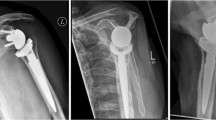Abstract
Asymmetric posterior glenoid wear caused by degenerative glenohumeral arthritis can be addressed by several techniques during total shoulder arthroplasty. The purpose of this study was to evaluate the midterm outcome of a posterior augmented glenoid component to determine the clinical and radiographic outcome, including complications and the need for revision surgery. Between 1995 and 1999, 13 patients (14 shoulders) underwent a shoulder arthroplasty with an augmented glenoid component to treat posterior glenoid bone deficiency. All 14 shoulders had advanced osteoarthritis. The minimum followup for these 13 patients was 2 years (mean, 5 years; range, 2–8 years). The mean age of these patients was 66 years at the time of surgery (range, 52–78 years). The mean active elevation was 160° (range, 120°–180°) and external rotation was 56° (range, 30°–90°). According to a modified Neer result rating system, 36% of patients had an excellent result, 50% a satisfactory result, and 14% an unsatisfactory result. Our results suggest patients undergoing total shoulder arthroplasty with an asymmetric glenoid component for osteoarthritis achieve satisfactory mid-term pain relief and improvement in function; however, instability is not always corrected. The advantage of this component seems marginal, and its use has been discontinued.
Level of Evidence: Level IV, retrospective review. See Guidelines for Authors for a complete description of levels of evidence.


Similar content being viewed by others
References
Cofield RH. Total shoulder arthroplasty with the Neer prosthesis. J Bone Joint Surg Am. 1984;66:899–906.
Habermeyer P, Magosch P, Lichtenberg S. Recentering the humeral head for glenoid deficiency in total shoulder arthroplasty. Clin Orthop Relat Res. 2007;457:124–132.
Hill JM, Norris TR. Long-term results of total shoulder arthroplasty following bone-grafting of the glenoid. J Bone Joint Surg Am. 2001;83:877–883.
Neer CS, Watson KC, Stanton FJ. Recent experience in total shoulder replacement. J Bone Joint Surg Am. 1982;64:319–337.
Sperling JW, Cofield RH, O’Driscoll SW, Torchia ME, Rowland CM. Radiographic assessment of ingrowth total shoulder arthroplasty. J Shoulder Elbow Surg. 2000;9:507–513.
Sperling JW, Cofield RH, Rowland CM. Neer hemiarthroplasty and Neer total shoulder arthroplasty in patients fifty years old or less: long-term results. J Bone Joint Surg Am. 1998;80:464–473.
Steinmann SP, Cofield RH. Bone grafting for glenoid deficiency in total shoulder arthroplasty. J Shoulder Elbow Surg. 2000;9:361–367.
Author information
Authors and Affiliations
Corresponding author
Additional information
Each author certifies that he or her institution has approved the reporting of these cases, that all investigations were conducted in conformity with ethical principles of research, and that informed consent for participation in the study was obtained.
About this article
Cite this article
Rice, R.S., Sperling, J.W., Miletti, J. et al. Augmented Glenoid Component for Bone Deficiency in Shoulder Arthroplasty. Clin Orthop Relat Res 466, 579–583 (2008). https://doi.org/10.1007/s11999-007-0104-4
Received:
Accepted:
Published:
Issue Date:
DOI: https://doi.org/10.1007/s11999-007-0104-4




